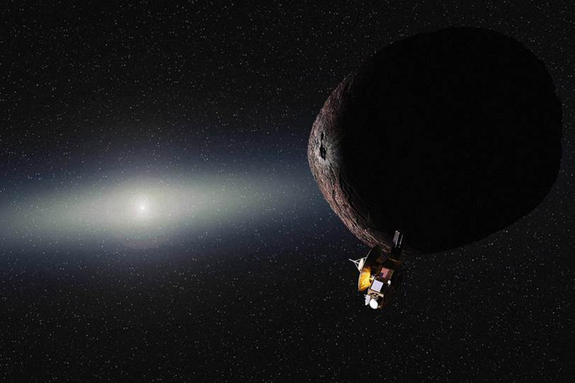
This image from the Hubble Space Telescope shows the Kuiper Belt object 2014 MU69.
Credit: NASA, ESA, SwRI, JHU/APL, and the New Horizons KBO Search Team
NASA’s New Horizons spacecraft captured the world’s attention when it buzzed Pluto in July 2015. In January 2019, it will set another record when it reaches another object in the outer edges of the solar system. Known as 2014 MU69, the ancient object will provide insight into the early life of the sun and its planets. Unlike other things explored by spacecraft, the tiny chip of ice and rock will be the first to be explored by a spacecraft launched before its discovery.
Both Pluto and 2014 MU69 lie within the Kuiper Belt , a collection of icy rocks that surrounds the outer reaches of the solar system. These objects are thought to be pristine samples from the early solar system, cast out into the boundary zone through gravitational interactions with the larger objects that would grow into planets. Examining them should reveal insight into what was happening in the solar system in the first stages of its lifetime.

Artist’s impression of NASA’s New Horizons spacecraft encountering a Pluto-like object in the distant Kuiper Belt. NASA announced on Aug. 28, 2015, that it had selected 2014 MU69 as its first choice for the probe’s secondary mission.
Credit: NASA/JHUAPL/SwRI/Alex Parker
Beyond Pluto
As early as 2003, the National Academy of Sciences’ Planetary Decadal Survey strongly recommended that the visit to Pluto include flybys of small Kuiper Belt objects (KBOs). Observing multiple targets would provide greater insight into the previously unexplored segment of the solar system. New Horizons launched in 2006 with extra fuel for such a flyby , and its power and communications systems are prepared to work at distances beyond Pluto’s orbit for years to come.
In 2011, mission scientists used ground-based telescopes to begin searching for a second target, but none of the new discoveries lay within the reach of New Horizons. In 2014, the Hubble Space Telescope joined the search, locating five potential objects. One of them was 2014 MU69, which was labeled 1110113Y after its June 26, 2014, discovery and PT1 (“potential target 1”) after its elevation to one of two possible destinations. In August 2015, the mission team selected 2014 MU69 as its next potential target .
“2014 MU69 is a great choice because it is just the kind of ancient KBO, formed where it orbits now, that the Decadal Survey desired us to fly by,” New Horizons principal investigator Alan Stern, of the Southwest Research Institute (SwRI) in Boulder, Colorado, said in a statement . “Moreover, this KBO costs less fuel to reach [than other candidate targets], leaving more fuel for the flyby, for ancillary science, and greater fuel reserves to protect against the unforeseen.”
Even with Hubble, details of 2014 MU69 are difficult to make out. The tiny object is estimated to be just under 30 miles (about 45 kilometers) across, less than 1 percent the size of Pluto. If the object is brighter, then it is likely smaller, while a darker object would be larger. Similar objects could have helped to build the dwarf planet in the past.
“There’s so much that we can learn from close-up spacecraft observations that we’ll never learn from Earth, as the Pluto flyby demonstrated so spectacularly,” New Horizons science team member John Spencer, also of SwRI, said in the statement.
“The detailed images and other data that New Horizons could obtain from a KBO flyby will revolutionize our understanding of the Kuiper Belt and KBOs.”
During an interview with the Planetary Society, New Horizons mission planner Mark Holdridge said that New Horizons’ first images of 2014 MU69 will be taken about 80 days before the encounter, in October 2018. When the spacecraft makes its January 1, 2019, flyby, it will pass even closer to 2014 MU69 than it flew by Pluto, though the exact distance is not yet known. At the time, the pair will be about 43.3 times as far from the sun as the Earth is.
Since the Pluto flyby, New Horizons has performed four maneuvers to intercept 2014 MU69, making an encounter inevitable. Less certain is the issue of whether or not the mission will receive funding approval to visit its second target.

This diagram shows the projected route of NASA’s New Horizons spacecraft toward 2014 MU69, orbiting in the Kuiper Belt about 1 billion miles beyond Pluto.
Credit: NASA/JHUAPL/SwRI
“Even as the New Horizon’s spacecraft speeds away from Pluto out into the Kuiper Belt, and the data from the exciting encounter with this new world is being streamed back to Earth, we are looking outward to the next destination for this intrepid explorer,” said John Grunsfeld, astronaut and chief of the NASA Science Mission Directorate at the agency headquarters in Washington, D.C.
“While discussions whether to approve this extended mission will take place in the larger context of the planetary science portfolio, we expect it to be much less expensive than the prime mission while still providing new and exciting science.”
Follow Nola Taylor Redd on Twitter @NolaTRedd or Google+ . Follow us at @Spacedotcom , Facebook or Google+ .

Comments are closed.